Edward J. Raynor, and Retta Bruegger* (12/20)
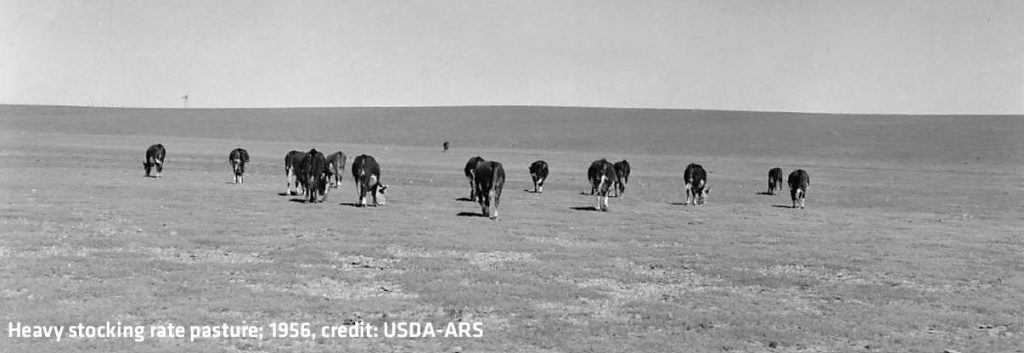
How long-term forecasts can help with stocking decisions
On the plains 75 miles east of Denver, researchers at the USDA-ARS Rangeland Resources and Systems Research Unit have been painstakingly measuring yearling weight gains since 1940. Over these 8 decades, they’ve measured these gains on light, moderate, and heavy stocked pastures during the summer grazing season. Now, new research correlates these gains with long and short-term climate and weather, like El Niño/La Niña. This gives new insight into how forecasts can be used to reduce uncertainty when dealing with drought.
Both overstocking and understocking can be financially risky, and producers make choices about stocking at a point in the year when much is unknown. While previous research identified cumulative spring precipitation from April to June as a key driver of yearling beef production in eastern Colorado, this new study shows how forecasts can inform stocking decisions even earlier. Results reveal how long-term forecasts, like the Pacific Decadal Oscillation (PDO) and the El Niño-Southern Oscillation(ENSO), explain 70% of the differences in weight gain over the 70+ year experiment.
What is the Pacific Decadal Oscillation (PDO)?
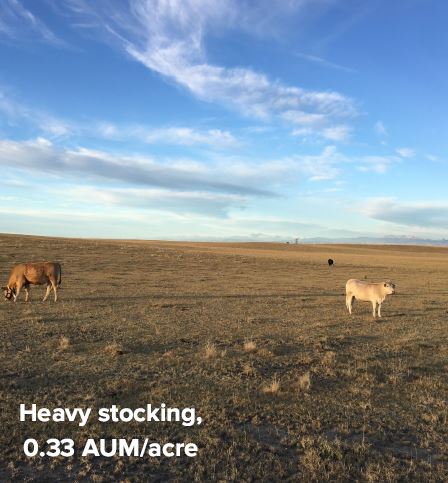
PDO and ENSO influence the climate in interior North America. PDO is associated with sea-surface temperatures along the West Coast in the Pacific Ocean. When sea-surface temperatures are warmer than average, rainfall is more likely in the Great Plains. This occurs during the Warm phase of the PDO. In contrast, Cold phase PDO over the Great Plains (last one was 1999-2013) typically leads to high variability in precipitation, when dry years like 2002, 2006,and 2012 can occur. Phases of the PDO switch between Warm and Cold on a 10-30 year cycle unlike ENSO (see below).
What is the El Niño-Southern Oscillation (ENSO)?
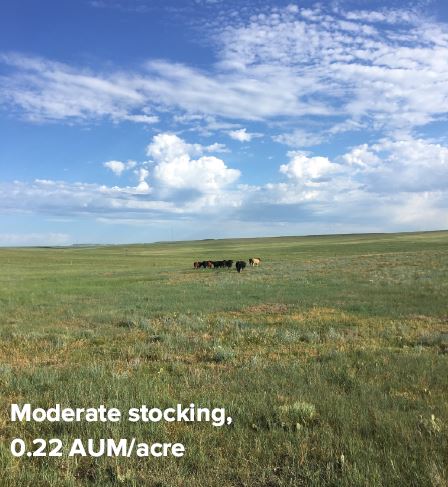
In contrast, ENSO hails from the equatorial region of the Pacific Ocean and, unlike PDO, which can span a few decades before switching phases, ENSO switches on a shorter time scale of 1 to 3 years. ENSO is well-known for being responsible for wet conditions during an El Niño period and dry conditions in a La Niña period. However, when ENSO is not strong enough to influence the climate of North America, this period is known as neutral. During “neutral” ENSO conditions, precipitation in the Great Plains is not driven by large-scale climate modes, irrespective of which phase the PDO is in. Given this, during a neutral ENSO, short-term local forecasts are the best source of information.
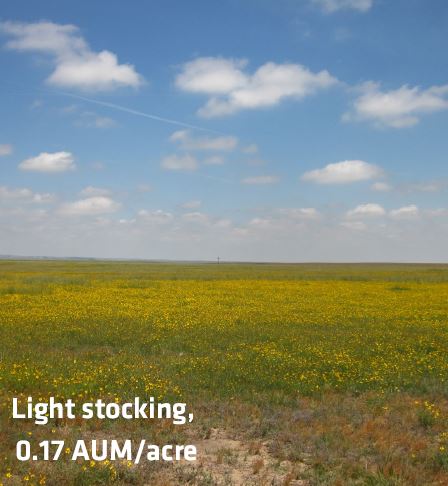
Heavy (top), moderate (middle), and light (bottom) grazing intensity pastures at the Central Plains Experimental Range near Nunn, Colorado during the current warm phase Pacific Decadal Oscillation. Photo credits: Edward J. Raynor (top, middle),Melissa Johnston (bottom). Animal Unit Months (AUM) are based on 19 year pasture averages spanning 2000-2018. Average annual rangeland production at the Central Plains Experimental Station is 658 lbs/acre, but fluctuates given conditions. For example, 2002 saw 98 lbs/acre and 2009 saw 1,415 lbs/acre. Average precipitation is 12 inches/year.
Using PDO & ENSO in Decisions
Using current PDO and ENSO phases with known precipitation received during the fall and winter (October to April), producers can adjust stocking rates prior to the growing season (e.g. in April) to reduce the risk of over- or under-stocking. The below decision support tree shows suggested stocking rate adjustments for livestock production (i.e., total pounds gained by livestock over the course of the year per acre) relative to moderate stocking levels (0.22 AUM/acre).
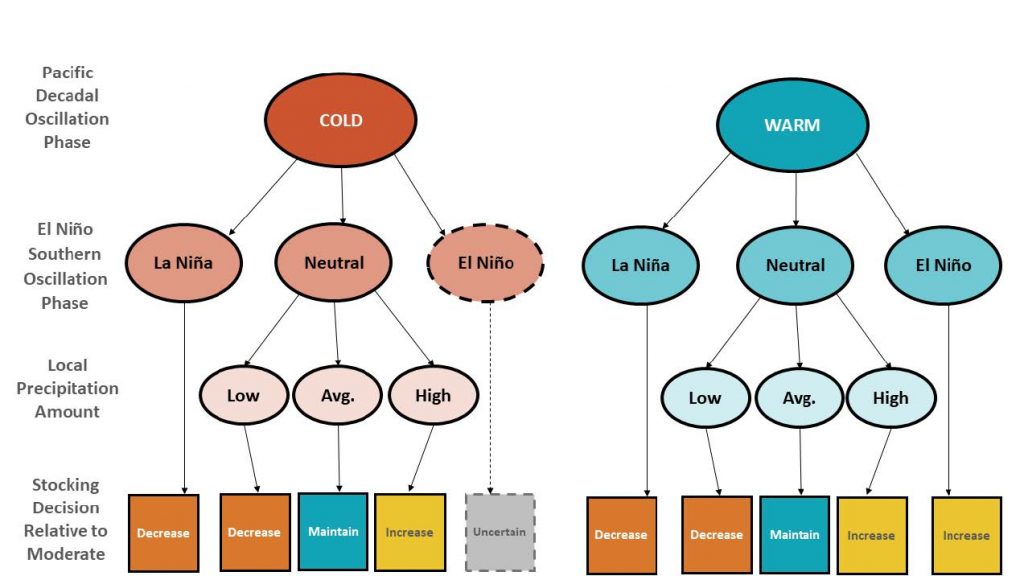
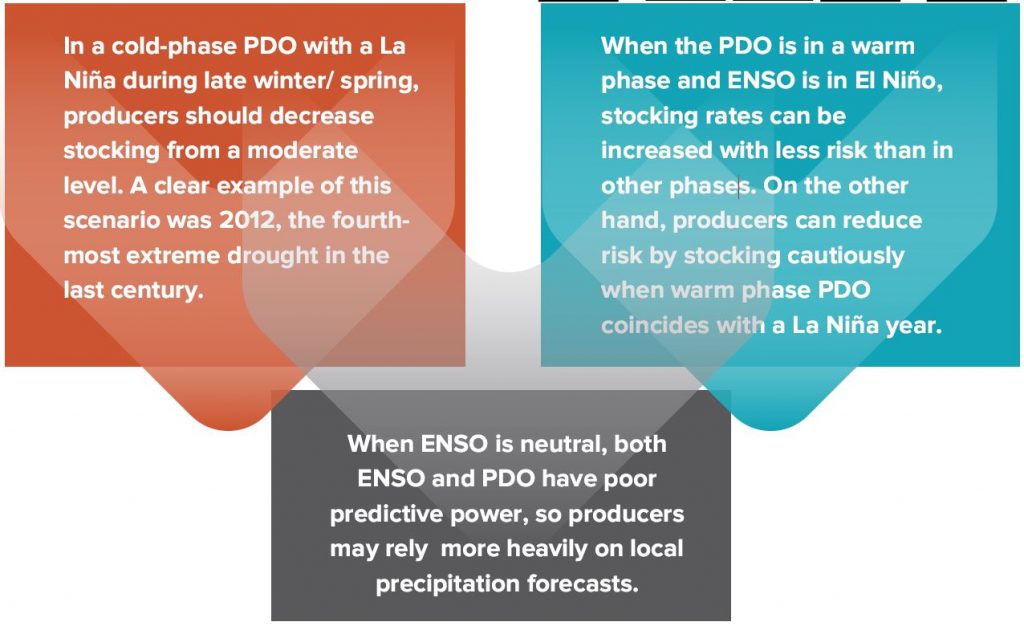
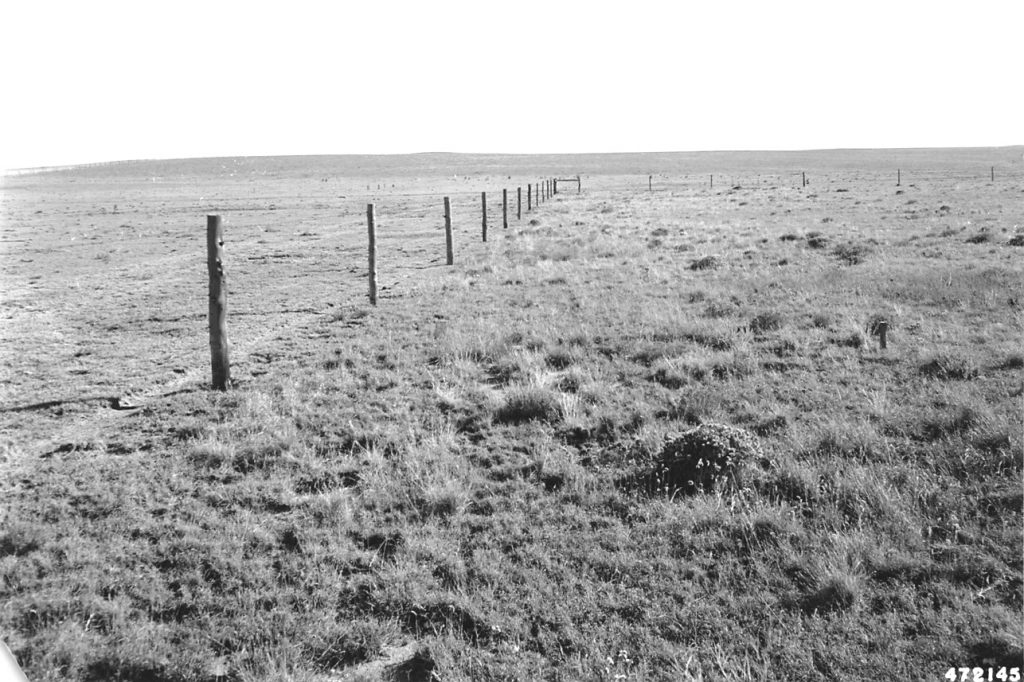
Applying Long- and Short-Term Forecasts in the Real World
Before the growing season in winter 2019/2020, researchers and others who manage cattle at the Central Plains Experimental Range knew that they were in the warm PDO phase, and that El Niño switched to a neutral phase (i.e., low predictive power) in the fall/winter 2019/2020. Working their way down the decision tree, they assessed local precipitation and conditions in April. They felt they had average residual forage going into the spring, and so stocked moderately.
Conditions in summer 2020 were worse than expected, and while they were able to make it through the growing season, doing so was challenging.
Moving forward to 2021, it is still warm on the PDO phase, and a high chance of La Niña for fall 2020. Given the decision tree, the suggestion then would bet to decrease stocking rate/ herd numbers in 2021 in eastern Colorado.
This application illustrates the use and limitations of using long- and short-term forecasts. But, the decision tree can give information about when and where the uncertainty lies to use in making stocking decisions.
In a survey of 307 ranchers in Wyoming, only 16% used forecasts to cope with drought (Kachergis et al. 2014).
Forecasts can have poor predictive value, and many factors can change a drought scenario quickly, so the lack of reliance on forecasts is understandable.
However, using forecasts can provide another tool in the toolbox to give early warning when coping with drought on Colorado’s eastern plains.
Large-scale Climate Mode Info
National Weather Service’s long-range climate resource
PDO: https://www.ncdc.noaa.gov/teleconnections/pdo/
ENSO: https://www.cpc.ncep.noaa.gov/products/analysis_monitoring/enso_advisory/ensodisc.html
Adapted from E.J. Raynor, J.D. Derner et al.2020. Large‐scale and local climaticcontrols on large herbivore productivity:implications for adaptive rangelandmanagement. Ecological Applications 30
(3):02053. 10.1002/eap.2053
Literature Cited:
E. Kachergis, J.D. Derner et al. 2014.Increasing flexibility in rangelandmanagement during drought. Ecosphere. 5.
10.1890/ES13-00402.1.
*Edward J. Raynor, USDA Agricultural Research Service, Rangeland Resources & Systems Research Unit, Fort Collins, Colorado & Retta Bruegger, Regional Specialist, Range Management, Colorado State University. 12/20.





